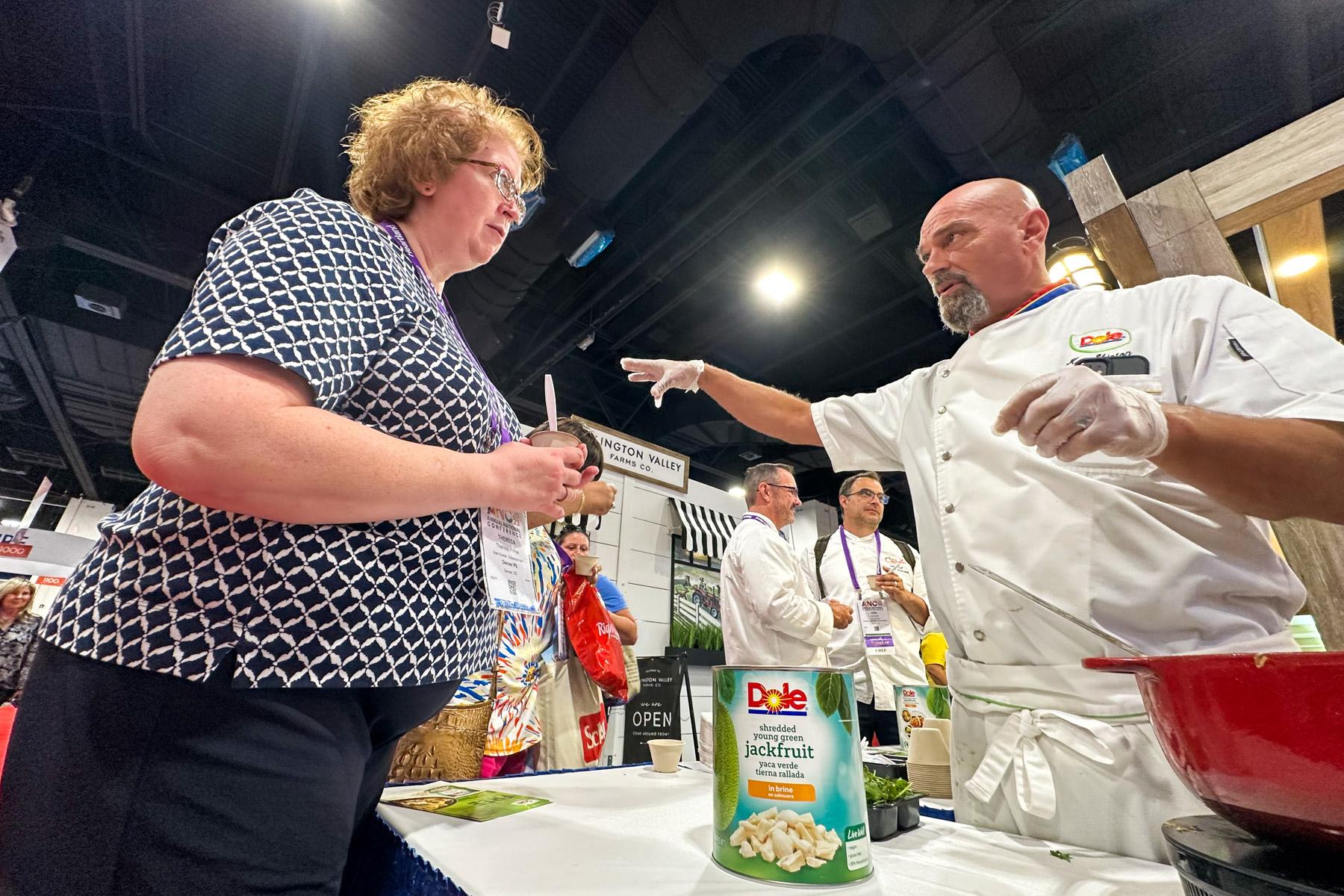
Theresa Hafner is prepared. Tennis shoes tied, comfortable slacks.
The nutrition director for Denver Public Schools looks out over the Colorado Convention Center’s 584,000-square-foot show floor. There are plant-based chicken nuggets, hair nets, fryers, cheese sauces, nifty knives, boxed chocolate milk and pretty packaging. Everything it takes to run a school cafeteria for thousands of children.
“There’s inspiration everywhere,” Hafner said, walking the show floor at the School Nutrition Association’s national conference in Denver this week.
She takes a bite of a sausage and egg “Uncrustable.” It’s a breakfast item she already serves but just wants to make sure it hasn’t changed.
“It’s fluffy, it’s whole grain. The bread tastes like it’s got maybe maple syrup or maple flavorings. It’s nice.”
Most of Denver’s cafeteria food is cooked from scratch. Hafner’s on the hunt for more recipes, portable equipment, and shelf-ready milk for when her fresh-milk dairies go on vacation over holiday breaks.
As Colorado districts gear up for the launch of the voter-approve Healthy School Meals for All, many nutrition directors are expecting to serve meals to thousands more kids. If a district participates, every single student can get free meals.
Hafner isn’t sure how many more students to expect. But she’ll be relying on new marketing strategies to erase any school lunch stigma to capture more kids.
“I think the fact that nobody will have to pay for a full meal … I don't think there will be the stigma of, ‘Oh the free kids get that meal and the rest of us are going over to Chipotle,’” she said. “We want to be their source on campus.”

Even higher-income districts expect to be serving many more kids.
Douglas County School District used to serve a quarter of its students. It is expecting a 40 percent increase in meals served. Cherry Creek and Littleton, a 30 percent increase. Many more Littleton students began eating at school when lunches were free during the pandemic.
“The students were like ‘I like this,” and then the parents realized, “I like this too, it’s a lot easier,” said Jessica Gould, director of nutrition services at Littleton Public Schools.
Nearby, Danielle Bock, nutrition director for Greeley-Evans School District 6, surveys the show floor. She and her team had already developed a plan of attack.
“We think ahead about the folks we want to talk to, the types of products we’re looking for, and we hone in on those people,” said Bock, who oversees a $6.5 million budget.
Her big question? Are there better ways and items to plan, cook and serve her 22,000-student district?
“How do we utilize (Colorado’s new way of calculating meal reimbursement) to speed up our line speed, especially in high schools where we have over 1,000 kids coming through in a 30-minute period?”
She’s also here to learn, with free meals for all, how her district can change the public’s perception about school lunch: “school meals being yucky, school meals being for poor kids.”
“They're some of the best tasting, scratch-made meals you're ever going to see. Where else can you get an unlimited salad bar for free? I mean, with nine different fruits and vegetables cut fresh daily? So, my other question, really, is how do we start leveraging this meal opportunity to market our meal programs in a way that changes public perception?”
By some accounts, Greeley 6 is already doing a pretty good job and could be a test case for other districts. It’s been offering free meals for all for the past three years. Sixty-five percent of students qualified for free or reduced price lunch. But 94 percent of Greeley’s students ate at school at least once this last year.
“Now, my staff think that we can serve 100 percent of kids, and I tell them … that’s a lot of meals, so I’m going to shoot for 95 next year, that’s what I want.”
It’s time to hit the convention floor. We’ll start with ... packaging!?
Yes, packaging. This isn’t the 1970s where you’re getting plop of meat, potatoes and vegetables on a cafeteria tray and you eat it. We’re in a generation of children that has been exposed to billions of dollars of marketing and advertising that targets them specifically. Add on celebrities flogging food items. Kids pay attention to that.
“What if I can get 94 percent of our students to eat with us 100 days of the year by adding something that is convenient and attractive?” Bock asks. “At the end of the day kids look at this … and they're going to stay on campus.”

She’s looking at a sandwich wedge in a sleek, upscale, natural-looking compostable package. It’s the fast-casual option students might see – and buy - off-campus because they attend a school with an open campus.
It’s all about the look.
As an experiment, Form Plastics served the sandwich wedge inside the upscale-looking, brown, compostable package. They sold it for $6. In the same district, they sold the same wedge sandwich in a standard plastic container for $1. The $6 sandwich sold out every day.
“People eat with their eyes,” Mike Anderson of Form Plastics tells Bock and her executive chef Kris Simmons. He said the packaging is 99 percent compostable so costs a bit more. But Simmons said there are tradeoffs.
“When you have packaging like this, you’re also not having to wash the dishes, you’re not having the tray come back so you’re saving the water and the soap and the chemicals for doing the dishes,” he said.
DPS nutrition director Hafner said she too has to compete with packaging like the “snackable” style, which kids love.
“How do I package the food that makes kids think it’s something they’d see in a commercial and that would be readily acceptable to them?”
Hafner struggles most to get high school kids into the cafeteria. Though 62 percent of DPS students were eligible for free and reduced-price lunch last year, just 30 to 40 percent took breakfast. Fifty-five percent took lunch. Hafner’s banking on next fall’s free meals for all — and a later start time for older kids — to boost numbers.
“And we feel that we might capture more kids who want to eat breakfast a little bit later. Maybe they weren’t hungry for it at 7:30 in the morning but maybe they are at 8:30 a.m.”
Select DPS high schools will also pilot kitchens that are open all day for students to grab items when they can. Hafner’s staff is attending sessions on how to market to high schoolers.
Move over meat, you’ve got company
One section of the floor, “alternative bites,” is buzzing with excitement. Vendors hope to entice a new generation of students with meat alternatives. Littleton’s Gould said for the past two or three years, students have been asking for more vegetarian options.
“We are consistently hearing, ‘Let's try and find some new things to bring in.’ So we've been adding two to three vegetarian items a year,” she said.
Gould searches for ways to introduce more proteins like chickpeas and falafel to “keep some variety on our menu, meet our students’ needs and bring some fun flavors.” Next year she’ll be adding a plant-based protein alternative like “beef crumble.”
DPS’s Hafner approaches the Dole booth, where there’s a line for a taste of the largest fruit tree in the world that’s covered in electric green bulbs of fleshy petals. Even Greek philosopher Theophrastus wrote about it in 300 B.C.

“I am super excited about this,” Hafner enthused, pointing to a large can. “This… is jackfruit.”
Young jackfruit is a massive and versatile fruit typically from Asia. But when cooked, it’s a vegan or vegetarian substitute for pulled pork or chicken. Chef Ken Shipton of Dole Packaged Food offers Hafner a sample.
“So, you’ve got a ‘jackfruit enchilada bowl’ made with our fresh young jackfruit…. it’s going to have brown rice black beans, a little bit of green enchilada sauce and some taco seasoning, a very simple one-pot meal.”
Hafner loves it. They discuss different spices and how to rinse the brine. In addition, some districts like Denver, Aurora and Greeley 6 have large numbers of Muslim students who don’t eat pork and some other meats not prepared in ways sanctioned by their faith.
Another booth, Rebellyous Foods, is hopping with business after some student ambassadors from Littleton Public Schools gave them rave reviews in a conference session.
“This looks like whole muscle…. like a real chicken nugget,” said nutrition director Danielle Bock before sampling a plant-based nugget.

“That’s delicious … that is really good! What is the protein, what are we using, what’s this made out of?” she asked Kristie Middleton, vice-president of the company.
“The protein is soy protein because of school nutrition requirements to be able to offer meat alternatives and to have a taste and texture that really mimics that of chicken we went with soy protein,” said Middleton.
At 77 cents a serving, the price is more than an actual chicken serving. But Middleton said engineers are developing and testing more efficient technology they expect will bring the price down for the 2024-25 school year. Rebellyous Foods’ chicken alternatives are currently in more than 150 school districts.
They are a top contender for Greeley cafeterias, said executive chef Kris Simmons. He said his first instinct is to use it for boneless wings.
“The wing bars have been really popular in our high schools. And boneless wings are in really high demand.”
The Littleton students reported that the plant-based nuggets’ outer crust was crispy.
“Flavor-wise they felt like it was pretty comparable to our current (chicken nugget) flavor,” said Littleton’s Jessica Gould. “They felt like the plant-based chicken nugget was just as good.”
Challenges still facing school cafeterias
Next school year, the federal government will reimburse meals at high-poverty schools in Colorado that are enrolled in the Community Eligibility Provision. Colorado’s voter-approved program will make sure the rest of children get free meals and that districts are reimbursed for the full cost of the meal.
Suffice it to say, for school nutrition directors, the paperwork for all this will be super complicated.
“Writing a revenue budget under Healthy School Meals For All probably requires a degree in economics, which I do not have,” joked Bock.
Families will still need to complete an application.
It’s a struggle to get families to fill out the form each year, making Colorado school districts lose out on federal dollars. And students will still have to use their IDs to get meals. That’s so the district can get federal funds. And — to help ID the hundreds of kids who have allergies or special diets.
In Greeley, the biggest challenge has been staffing. Since March 2020, the district hasn’t been less than 15 percent short on staff. What’s that like in the average cafeteria?

“Exhaustion,” said Bock.
Colorado’s free meal measure also calls for a living wage for cafeteria workers and incentives for buying local produce. But those two elements don’t go into effect until the 2024-25 school year.
Schools are also charged with gradually limiting how much sugar children consume and strict new sodium requirements, significantly different from what they eat at home.
Despite all the challenges, school nutrition directors are excited about the opportunity to feed more children this fall.
“Simply put, it fuels them to learn,” said Bock. “None of us function well when we're hungry. Kids are no different. When we're nourishing them, they're going back into class and they're succeeding and they're learning. If we're building our next set of humans that are going to run this country, we need them to be nourished in order to grow.”









